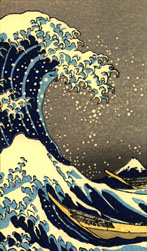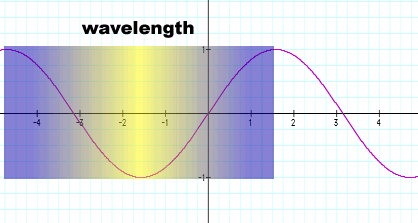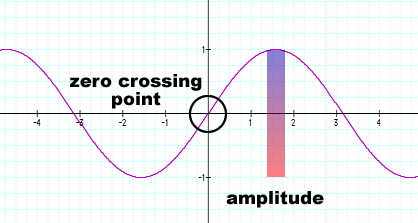
"Art is born of the observation and investigation of nature."
— Cicero (106 BC - 43 BC)
"Art is born of the observation and investigation of nature."
— Cicero (106 BC - 43 BC)
Information travels as a series of waves.
The ebb and flow of wave mechanics is described as analog. Electricity is analog, and so is electronic media. But digital media is an abstraction of these waveforms; a map or grid of discrete numeric values.
Cycles and Wavelength

Frequency and Amplitude

 |
 |
|
LOWER FREQUENCY
|
HIGHER FREQUENCY
|
Resonance and Reflection
Electromagnetic waves
The electromagnetic spectrum encompasses a vast range of frequencies from gamma and x-rays on one end, to a narrow band of visible frequencies sort of near the middle, to microwave and radio frequencies on the longer-wavelength end.
| Wavelength | Frequency | |
|---|---|---|
| 10pm | 30,000,000 THz | Cosmic Rays |
| 10-100 pm | 30,000,000-3,000,000 THz | Gamma Rays |
| 0.1-10 nm | 3,000,000-30,000 THz | X-Rays |
| 10-200 nm | 30,000-1500 THz | Vacuum Ultraviolet |
| 200-280 nm | 1500-1070 THz | Ultraviolet (UVC) |
| 280-315 nm | 1070-950 THz | Ultraviolet (UVB) |
| 315-400 nm | 950-750 THz | Ultraviolet (UVA) |
| 400-750 nm | 750-400 THz | Visible Light |
| 0.750-1000 Ám | 400-0.3 THz | Infrared |
| 1-100 mm | 300-3 GHz | Microwaves |
| 100mm | 3GHz | Radio Waves |
| Frequency | Classification |
|---|---|
| 3-30 kHz | Very Low Frequencies (VLF) |
| 30-300 kHz | Low Frequencies (LF) |
| 300-3000 kHz | Medium Frequencies (MF) |
| 3-30 MHz | High Frequencies (HF) |
| 30-300 MHz | Very High Frequencies (VHF) |
| 300-3000 MHz | Ultra High Frequencies (UHF) |
| 3-30 GHz | Super High Frequencies (SHF) |
| 30-300 GHz | Extra High Frequencies (EHF) |
| 300-3000 GHz | Microwave Frequencies |
Electromagnetic waves are unique forms of energy, known as radiant energy. They are created when electrically-charged particles, such as electrons, are made to move. As the charged particles move they generate fields of electrical and magnetic energy. These two forms of energy radiate from the particles as electromagnetic waves.
Although the forms are given different names, such as X-Rays, radio waves, these are really all part of a single, continuous range, or spectrum, of electromagnetic radiation. At one end of the spectrum are the very-short-wave radiation which have the power to penetrate matter. Examples of this type are X-rays and gamma rays. Ultraviolet radiation is also penetrating but to a lesser extent. Light itself is another form of penetrating radiation, as is infrared. Somewhat longer than infrared waves are microwaves. They still have some penetrating power but the longer the wavelength the greater the absorption and deflection by materials.
top of page
Artificial Waves
Electronic waves are generally produced by a component called an oscillator.
 |
 |
|
Sawtooth wave.
Used to control the color guns of a CRT. |
Pulse wave.
Used for timing purposes. |
A triangle wave is like a sine wave except that its action is linear. It gradually builds to its maximum voltage and gradually falls to its minimum amplitude. They are used primarily in sound synthesis.
A sawtooth wave, also called a ramp wave, gradually builds to its maximum voltage/amplitude, then abruptly drops to its minimum value. It is used in the control of electronic guns for CRT displays.
A rectangular wave jumps abruptly from its minimum voltage to its maximum. This yields a series of pulses used for timing and synchronization. For this reason they are also called pulse waves. The duration of the on state is called the pulse width or duty cycle. The square wave has a 50% duty cycle yielding equal on and off times.
More complex waves can be created using a technique called modulation. This is used in radio and television transmission.
 |
+ |
|
= |
||
 |
||
Transducers
Conversion from one medium to another requires a transducer. An example is a microphone (to convert sound into electrical waves) and conversely, speakers that convert electrical waves into audible sound.
Conversion allows for processing of the wave.
The amplitude of the wave can increased to higher levels or reduced (attenuated) to lower levels. This is volume in audio, and brightness in video. Amplifiers are employed to boost signal strength when the signal must travel long distances or is split among many paths. Amplifiers are most often used to boost the low level electrical signal of a transducer to final program levels. Your stereo amplifier is an example.
Filtering is another way to process the wave. Cut-off filters set a level at
which attenuation occurs. Low pass filters attenuate frequencies above the cut
off point. High pass filters attenuate frequencies below the cut off point.
A band pass filter rejects all frequencies outside a certain frequency band.
A notch filter excludes only those within a certain frequency band.
top of page
Analog and Digital
Waves and electromagnetic fields are analog, meaning thay are continuous signals capable of smooth fluctuation. Electric current is also analog. Analog is characterized by flowing current (water, air, electricity). Electricity is a current of electrons. Direct current (DC) is indicative of a one-way flow, while alternating current (AC) indicates an oscillating flow.
Analog media (videotape, audiotape) are linear media. Digital media (floppy
disk, CDs) allow for random access of information. One main reason to convert
analog information to digital is to facilitate access to information.
top of page
Conversion between Analog and Digital
Analog to digital converters (ADCs) accept an analog voltage and convert it to a series of discrete numbers, called digitizing, or sampling. Digital to analog converters (DACs) transform a series of discrete numbers to a continuous analog voltage.
The sampling rate determines how often the signal is digitized. Sampling rate must be twice as high as the highest frequency to be represented. The resolution refers to how many bits are reserved to measure the amplitude of the analog wave. The greater the bit resolution, the more faithful the interpretation of the source.
Quantization occurs when a source value falls between the values at a given
resolution. Aliasing occurs when the sampling rate interferes with the frequency
of the program material. In general, oversampling mitigates this problem. Interpolation
can be used by DACs to reconstruct missing samples.
top of page
Electromagnetic Transducers and Magnetic Media
|
Decibel:
|
(dB) A logarithmic scale used to measure sound and light levels. It is one tenth of a Bel, which is a power ratio of 10:1. |
|
Frequency Response:
|
The lowest and highest frequencies that can be transmitted or received by a medium. |
|
Dynamic Range:
|
The range between the weakest and strongest signal a component can faithfully replicate (often measured in dB). |
|
Noise:
|
Any unwanted frequencies accompanying program material. |
|
Signal to Noise Ratio:
|
All circuitry exhibits some background noise called the noise floor. The ratio describes the difference between the optimum program level and the noise floor. The larger the difference the better. |
|
Bandwidth:
|
The difference between the extremes of a device's frequency response. Bandwidth determines a device's throughput. Measured in mHz, a device's bandwidth would be the highest mHz frequency it can handle minus the smallest. |
|
Distortion:
|
A change in the signal from its original form. Non-linear is the result of output that does not rise and fall in relation to input. Amplitude distortion describes differences in scale or ratio between input and output as amplitude changes. Harmonic distortion results from harmonic frequencies being added in amounts proportionate to input amplitude. Intermodulation distortion adds frequencies that are not hamonics of component frequencies. Flutter distortion results from time-base deviations in physical components, such as tape transports. Frequency distortion is frequency content in output not present in input. Phase distortion refers to phase relationships that differ between input and output. |
|
Fidelity:
|
How faithfully a component reproduces original program material. Frequency response, signal-to-noise ratio, and distortion are all part of fidelity. |
|
Saturation:
|
The point at which additional input does not affect output. Headroom is the difference between average signal level and saturation level. |